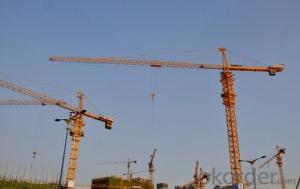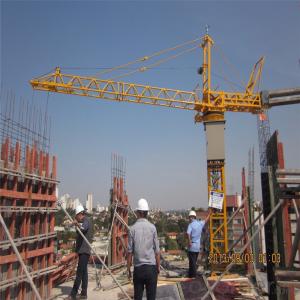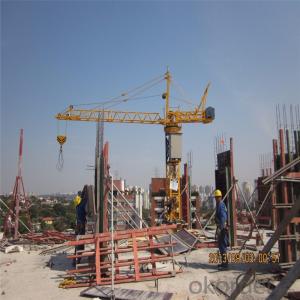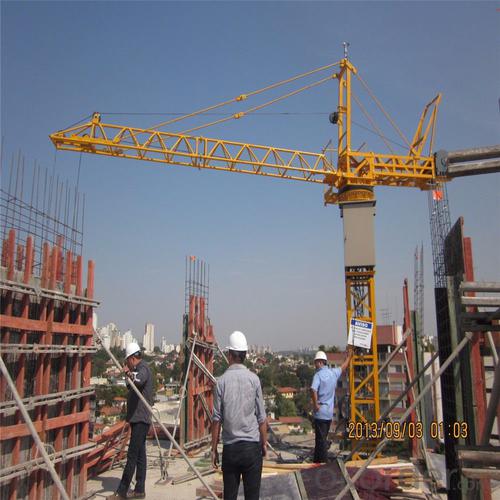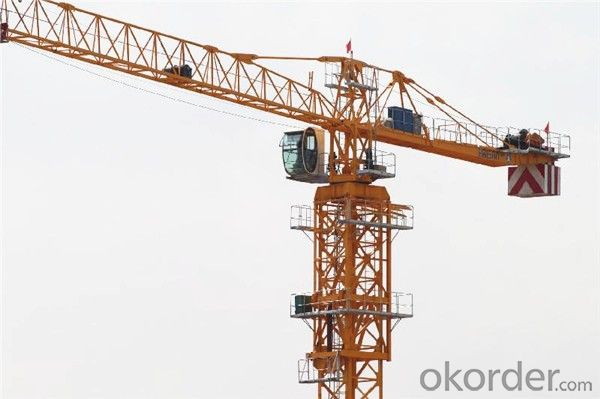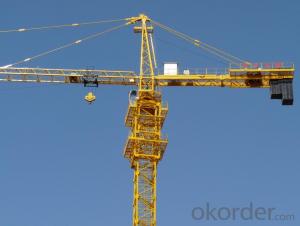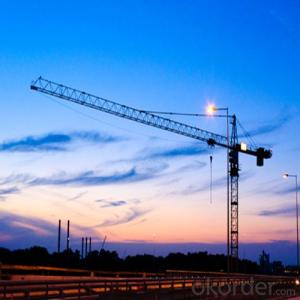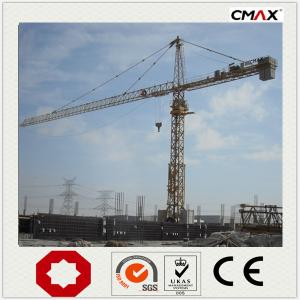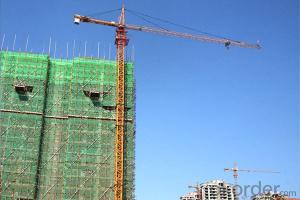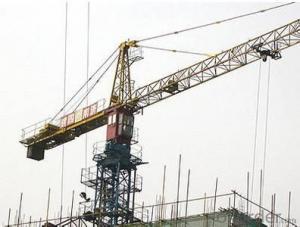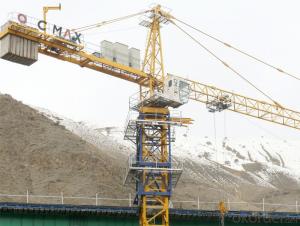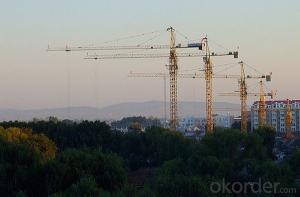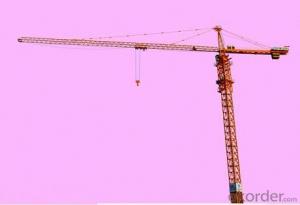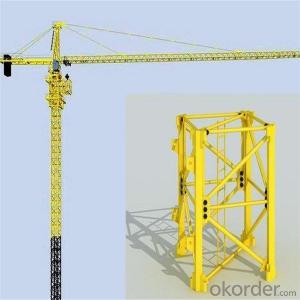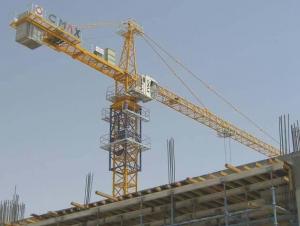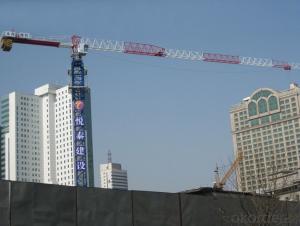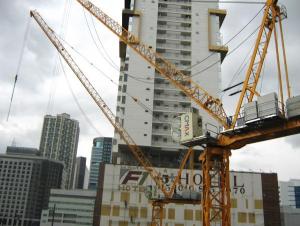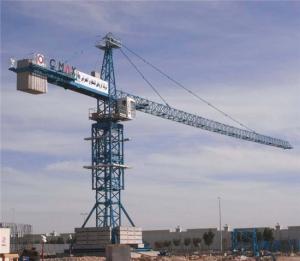Tower Crane of Jing Kui Model Number QTZ4708
- Loading Port:
- Qingdao
- Payment Terms:
- TT OR LC
- Min Order Qty:
- 1 unit
- Supply Capability:
- 30 unit/month
OKorder Service Pledge
OKorder Financial Service
You Might Also Like
QTZ4708 Description
Feature: Tower Crane
Condition: New
Rated Loading Capacity: 4T
Rated Lifting Moment: 400
Max. Lifting Load: 4T
Max. Lifting Height: 129
Span: 47
Place of Origin: Christmas Island
Brand Name: JINKUI
Model Number: QTZ40(4708)
Warranty: one year
After-sales Service Provided: Engineers available to service machinery overseas
Certification: ISO9001:2000; CE;Ukraine & Belarus Certificate
Colour: Orange/ Yellow
QTZ4708 Features
1.Thirteen years of experience in supplying new self-erecting tower crane with Huiyou Brand.
2. Export to more than 20 countries with CE/ISO/GOST Certificates.
3. Stationary/Travelling, external/ internal climbing tower crane
4. Impeller blasting/rust protection paint
5. Advanced painting process
6. Potain masts designed with dismountable panels, making teansport easier and cheaper.
7. New designed mast, can be used to Internal and external climbing tower crane
8. Famous brand mechanism system, Schneider Electronic control system, jiangte and jiuhe motor
9. Engineers available to service machinery overseas.
QTZ4708 Specification

QTZ4708 Pictures
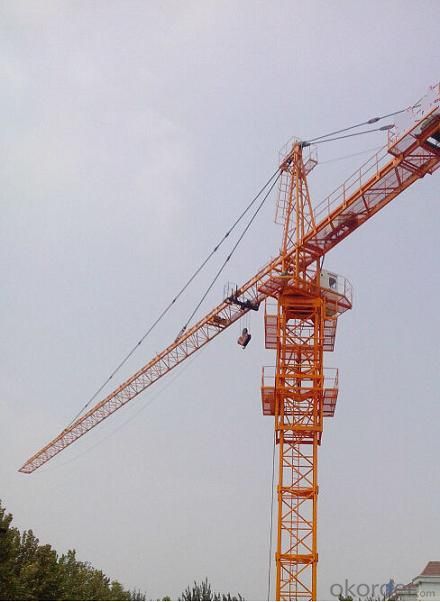
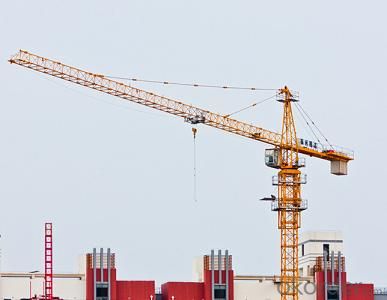
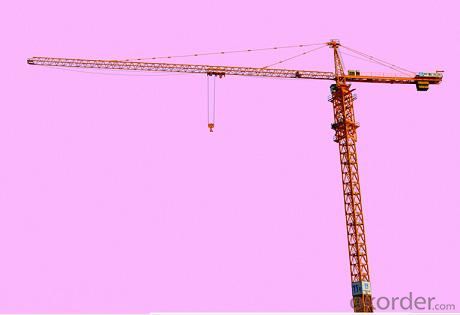
QTZ4708 FAQ
Q: What is tower crane?
A: Tower crane is a modern form of balance crane that consist of the same basic parts. Fixed to the ground on a concrete foundation (and sometimes attached to the sides of structures as well), tower cranes often give the best combination of height and lifting capacity and are used in the construction site.
Q: What is the meaning of the tower crane’s code?
A: Take TC5013 for example, the first two letters “TC” means Tower Crane, “50” means jib length is 50 meter, and the last two letter “13” means the tip load is :1.3 ton.
Q: Can you equip with light on tower crane jib, monitor, remote control and anemometer?
A: Sure. All of these could be provided with extra cost upon the clients’ requirements. But according to general practice, remote control is not suggested because most of the operator feedback operation in the cabin will provide a wide working view.
Q: What is the function of the monitor?
A: Monitor, namely inspection system (like black box), which could store 10000 tower crane operation reports, and it is recommended to be installed in big cranes more than 16t.
- Q: Tower cranes should stop working when the wind speed is greater than the magnitude.
- Tower crane should stop working when the regulation is greater than or equal to six wind.When the wind is greater than or equal to four, the lifting operation shall be stopped.
- Q: plz help me
- The Whooping Crane (Grus americana) is a very large crane. It is the tallest North American bird and the only crane species found solely in North America. Adults are white; they have a red crown and a long, dark, pointed bill. They have long dark legs which trail behind in flight and a long neck that is kept straight in flight. Black wing tips can be seen in flight. Immature birds are pale brown. Their breeding habitat is muskeg; the only known nesting location is Wood Buffalo National Park in Canada and the surrounding area. They nest on the ground, usually on a raised area in a marsh. The female lays 1 to 3 eggs. Both parents feed the young. Usually no more than one young bird survives in a season. Loads more on Wikipedia (link below) - good luck
- Q: im so frustrated because ive tryed everything and im obsessed with this book it would really help if someone could find a way for me to read it for free online. i cant find it at my library.please and thank you:)?
- Shelly Crane is not giving the book away for free so any online site that has it, has stolen intellectual property.
- Q: I've heard of people making 1000 origami cranes as a wedding gift or decoration. I am making them as a gift for my sister-in-law and her husband, whose new baby is due next month. I'm up to 730, so I need to keep plugging away! My question is how should I display them? I've heard of putting them in a gallon jar. I was also thinking of making strings of 100. Do you put the string through the pointy part on the back? Can I arrange them into a mobile? Any ideas would be appreciated.
- it relatively is like asking: once you're making a wish on a taking pictures megastar, will it come real? even although the two are extreme-high quality gestures, no it won't come real. Origami cranes are purely products of paper that are folded to resemble birds; no rely what number you're making, they won't address supernatural expertise inclusive of wish-granting.
- Q: Please help me. I have to write and essay about it and i cant find it on the web!! no anywhere i can get it from ONLINE?!?!?! any particular search engines?
- nicely, on the initiating i grew to become into watching this snippet of Zeigeist while they have been conversing approximately Jesus and faith oftentimes (that's incredibly lots my quest at that element) after which I stumbled upon the the remainder of it... Which grew to become into like, whoa... you'll be able to desire to comprehend... i'm from Malaysia (that's in South East Asia) and that i observed the twin Towers coming down at nighttime on CNN. on the initiating i presumed it grew to become right into a action picture, until eventually my mom advised me this is not. It sparked an obsession with me... I watched CNN day and nighttime almost for the full month, into Iraq and all, searching for updates into the situation. that's why each and every thing clicked into place when I watched Zeitgeist. additionally, being in a Muslim united states has given me an decision view on the full rely being that they teach the brutality of the yank military in Iraq. Yeah, so it makes extremely some experience. i don't comprehend why some human beings discover it so stressful to have self belief. while? Oh... early this year. ;-) i know i'm overdue, yet for an prolonged time I had different issues occupying my ideas (migrating from one united states to a diverse and such). happy to work out extremely some truthers around! in case you may desire to hook up with me, i could better than gladly oblige. =)
- Q: What does the crane mean to the Korean people?
- Long Life
- Q: Yeah, I think I know what cranes are used for. But in the context of building an apartment and so on, what is the role derricks there. And why is called cranes and derricks - What is the correlation between them.
- Cranes are used for lifting heavy equipment. Derricks are used to drill for oil. They are two different things.
- Q: Today, a crane collapsed on the Grand Mosque in Mecca, killing 87 people. Is God punishing Muslims for 9/11?
- Lightning okorder
- Q: How to distinguish self lifting tower crane with counterweight and lifting tower crane without counterweight
- With the weight of the tower crane is mainly ordinary tower cap tower crane, tower crane and tower crane type, is made of concrete counterweight pieces of the balance arm, is also useful for iron making, but relatively rare.The tower crane without counterweight is mainly a city quick loading tower crane. It is characterized by the absence of balance arm, and it is impossible to have counterweightThe layman can not tell the can see the appearance, there are long steel structure before and after the weight of the tower body, and no weight of the tower body with only one steel structure (i.e. jib crane, structure)
- Q: what does the expression, fate is a ninny woman, mean. from open boat by stephen crane?
- Well, it means Crane was sexist, for one thing. :o) I think it means that he thought that fate could be fickle, capricious, and not appear to be very smart compared to how we would like things to turn out.
Send your message to us
Tower Crane of Jing Kui Model Number QTZ4708
- Loading Port:
- Qingdao
- Payment Terms:
- TT OR LC
- Min Order Qty:
- 1 unit
- Supply Capability:
- 30 unit/month
OKorder Service Pledge
OKorder Financial Service
Similar products
Hot products
Hot Searches
Related keywords
